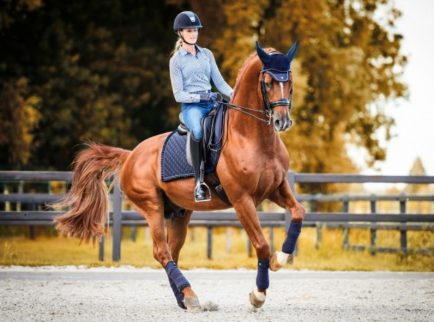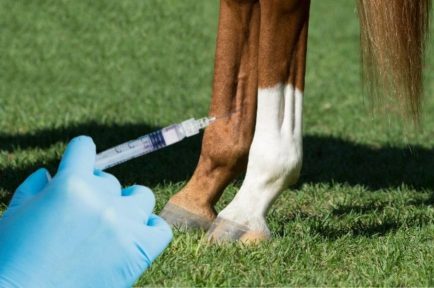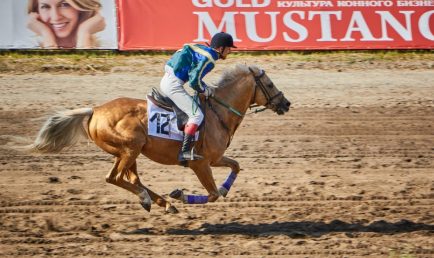Cauda equina syndrome is something that many horse owners are not familiar with. So, what surrounds the cauda equina? Though this is a rare disease, it can be very serious in horses.
Many people are not familiar with cauda equina syndrome as it is rarely recognized in horses. It can be the result of myriad infectious, inflammatory, and/or traumatic factors. It is a type of neurological disease that can have serious effects on horses.
What Is Cauda Equina Syndrome In Horses?
Cauda Equina Syndrome, also known as Cauda equina neuritis or polyneuritis equi, is a chronic relapsing, peripheral neurodegenerative disorder in horses that is non-infectious. It causes inflammation of the nerves surrounding the sacral vertebrae at the bottom of the spine, near the pelvis. In addition, it can sometimes affect other nerves, including cranial nerves.
Cauda equina syndrome has been seen in adult horses of all breeds across Europe and North America. Though the cause is generally unknown, it can be an immune response to a viral infection. It was first described in horses in 1897 in Germany.
Cauda equina syndrome affects the horse’s sacral and coccygeal nerves. This refers to a bundle of spinal nerves and spinal nerve roots, which are found in the spinal cord. In return, it causes paralysis of the tail, rectum, and bladder.
Some recent research suggests that cauda equina neuritis may be associated with infections caused by Sarcocystis neurona. This is the same parasite that causes Equine protozoal myeloencephalitis (EPM) in horses. However, the traditional theory of the cause of cauda equina neuritis points to it being immune-mediated.
What Surrounds The Cauda Equina And Where Is It?
The cauda equina is the tapered end of the spinal cord that is surrounded by extensions of spinal nerve roots extending alongside and past it. It affects the horse’s sacral and coccygeal nerves, which can cause serious problems when damaged.
As a result of the inflammation associated with this syndrome, the sacrococcygeal spinal nerve roots can appear to emerge from the dura covering the terminal spinal cord. When this happens, there is also often swelling associated with the condition.
It is called cauda equina as it has the appearance of a horse’s tail. In Latin, cauda equina translates to ‘horse tail.’
Symptoms Of Cauda Equina Syndrome
Common cauda equina neuritis symptoms include tail rubbing, tail weakness/paralysis, urinary and fecal incontinence, behavioral changes, muscle atrophy of the coccygeal muscles, and protrusion of the penis. Some horses may also experience hypalgesia or analgesia of the tail, anus, and skin of the perineum.
In certain cases, horses may have mild signs of pelvic weakness, ataxia and muscle atrophy in the hind end area may occur. Subtle signs of the syndrome may also include decreased tongue tone, reproductive dysfunction such as impotence, urine ejaculated in semen, and urine pooling in mares.
Though cauda equina may cause weakness in the hind end, there are usually no abnormalities in the gaits. In other neurological disorders, gait abnormalities are a common occurrence.
Causes Of Cauda Equina Syndrome
In many cases, the cause of cauda equina syndrome is unknown. However, trauma to the sacral/coccygeal area of the horse is the most common cause of this syndrome. This can result from falls, horses backing up under obstructions, and intense tail pulling.
Neuritis, which is nerve inflammation, of the cauda equina is rare. It causes a gradual, progressive onset of clinical signs when it occurs.
Non-traumatic causes of cauda equina syndrome include vertebral osteomyelitis, equine herpesvirus-1, EPM, epidural neoplasia, caudal meningitis, rabies, verminous myelitis, and sorghum/sudan grass toxicity. It is not uncommon for the true cause to be unknown.
Diagnosis Of Cauda Equina Syndrome
If your horse is experiencing any of the symptoms of cauda equina syndrome, you should contact your veterinarian. A veterinarian will often perform a physical examination while looking for any additional findings of infectious, inflammatory or traumatic causes. In addition, your veterinarian may also perform a neurologic examination as well.
Treatment Options – What Surrounds The Cauda Equina
Unfortunately, the disease gradually progresses even with treatment. However, treatment options can still help your horse. Oftentimes, treatments for the underlying cause of cauda equina are administered.
Non-specific treatments include non-steroidal anti-inflammatory medication. Supportive nursing care such as bladder drainage/lavage, prophylactic antibiotics for bladder infection, topical skin treatment, manual fecal removal, and fecal softeners are often given as well. Since there is no cure for it, treatment plans vary by the individual horse and the symptoms the horse has.
Cauda Equina Syndrome In Horses
Cauda equina syndrome is a rare neurologic disease in horses. It affects the sacral and coccygeal nerves, which are a bundle of spinal nerves and spinal nerve roots found in the spinal cord. It can lead to paralysis of the tail, rectum, and bladder and cause tail rubbing, hind end weakness, urinary and fecal incontinence, and behavioral changes.
Original article: What Surrounds The Cauda Equina? – Best Horse Rider
Royal Equestrian – Riding Apparel, Horse Fashion, Horse Tack (royalequestriancollection.com) – check our website to purchase and enjoy our products for your horses and you.



























